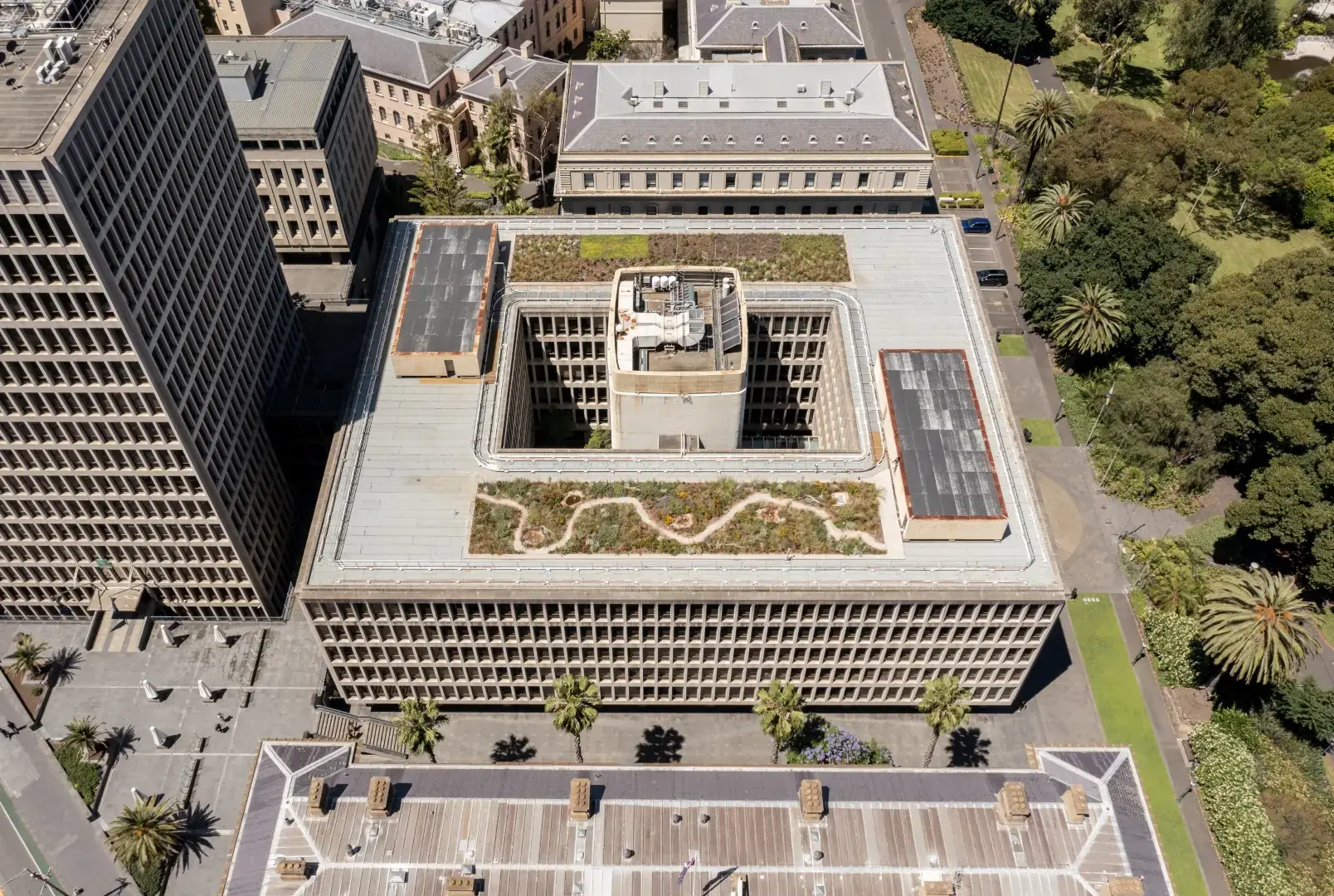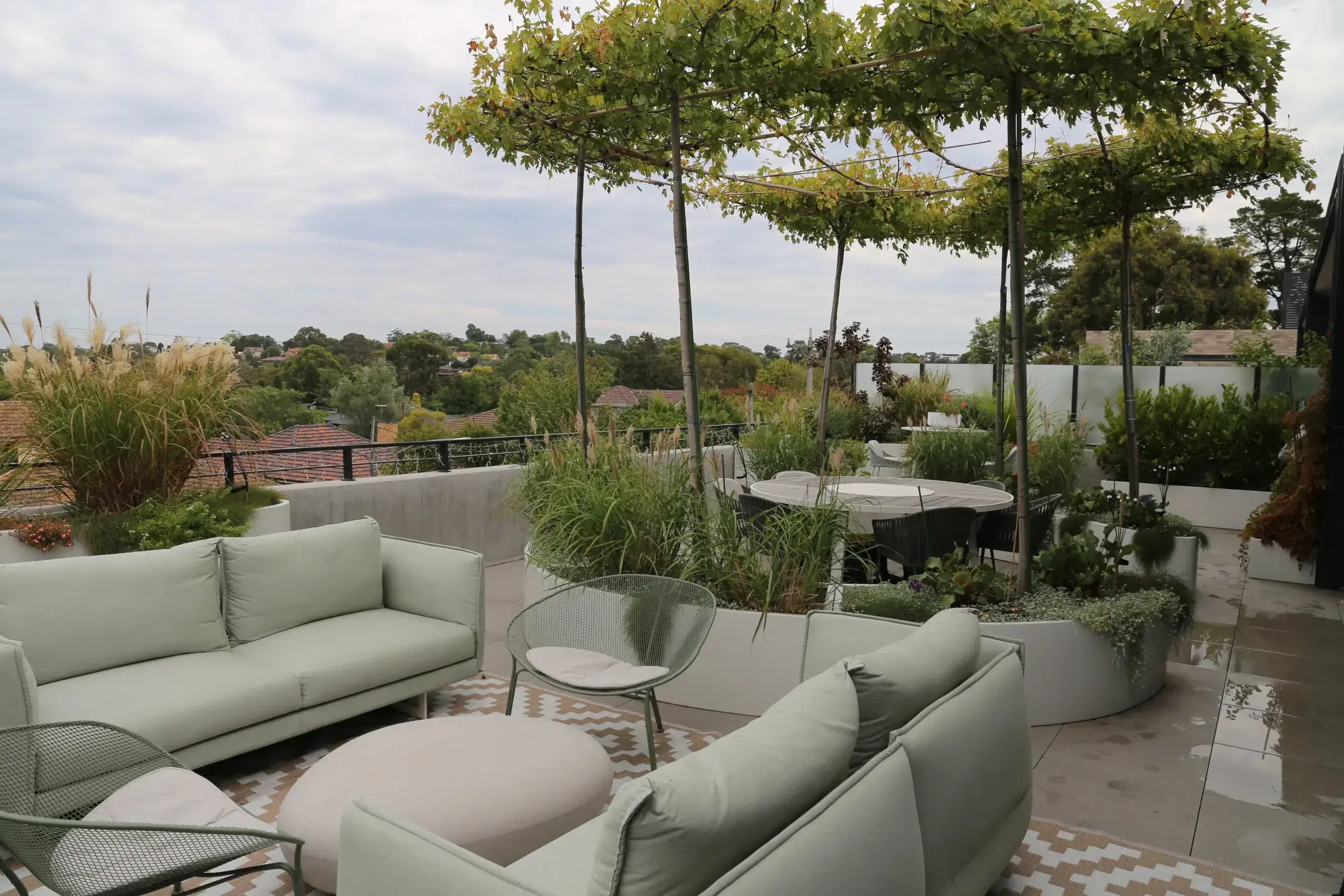Green Roofs
Enhance your building and the environment with a stunning green roof. Evergreen Infrastructure designs and installs beautiful rooftop gardens in Melbourne.






.webp)
.webp)
.webp)
Is your rooftop just wasted space?
Your rooftop could be doing so much more. It's currently sitting unused, offering little for you or the environment.
Imagine transforming it into a green oasis – increasing thermal mass, cleaning the air, and creating a beautiful space to enjoy.
With Evergreen Infrastructure, you can reap the rewards of a green roof. Our solutions are tailored to your unique needs and vision.
The Benefits
Storm Water Mitigation
Green roofs absorb rainwater through plants, substrate, and drainage layers, delaying discharge into sewage systems. This process purifies water, promotes evaporation, stabilises groundwater, and reduces flood risk, alleviating strain on sewage systems.
Improved Air Quality
Green roofs aid air purification by filtering particulate matter and converting carbon dioxide into oxygen via plant photosynthesis, enhancing urban air quality and mitigating pollution levels.
Increases Biodiversity
Green roofs promote biodiversity by creating habitats for various plants and animals, contributing to urban ecosystems' health and resilience while enhancing environmental sustainability in densely populated areas.
Increased Well Being
Green roofs elevate well-being by offering green spaces for visual and physical interaction in urban environments. This fosters relaxation, reduces stress, and enhances connections with nature, enriching communities' health and happiness.
Return on Investment
Green roofs increase property value due to their natural and sustainable appearance, energy cost reduction, and extended roof lifespan, enhancing overall building desirability and investment potential.
Ambient Temperatures
Green roofs lower ambient temperatures by absorbing and reflecting sunlight, reducing indoor air conditioning needs, thus saving energy and cooling urban areas. This contributes to a healthier local climate and environment.
Projects
Features
Extensive Green Roofs
Extensive green roofs are lightweight and low-maintenance and host resilient plant species. They manage stormwater, insulate, and support biodiversity, ideal for urban areas with limited support. These sustainable roofs demand minimal upkeep, offering lasting environmental benefits.
Intensive Green Roofs
Intensive green roofs are intricate vegetated systems boasting deep soil and diverse plantings requiring regular maintenance and irrigation. Unlike extensive systems, they emphasise aesthetics and recreation, ideal for sturdy buildings seeking vibrant green spaces despite higher maintenance needs.
Blue green roofs
Blue-green roofs merge green and conventional roofing elements, integrating vegetation with water management features like retention ponds. This hybrid system effectively controls stormwater runoff, offering a sustainable solution for urban areas.
FAQs
The maintenance required for green roofs can vary depending on their type and complexity. Extensive green roofs, with shallow soil depths and hardy plant species, generally require less maintenance compared to intensive green roofs, which feature deeper soil and diverse plantings. However, all green roofs typically require some level of maintenance, including tasks like irrigation, weeding, pruning, and occasional replanting. Regular inspections and upkeep are necessary to ensure their longevity and optimal performance. While they may require more attention than conventional roofs, many find the benefits they offer justify the effort.
Maintaining a green roof requires commitment, horticultural knowledge, and potentially working at heights certificates and training. While basic tasks like watering and weeding can be managed by anyone, more complex maintenance may necessitate professional expertise. Understanding the specific needs of the green roof system and its plants is crucial for its health and longevity.
Yes, green roofs offer numerous environmental benefits. They mitigate urban heat island effects by absorbing and deflecting solar radiation, reducing temperatures in urban areas. Additionally, they improve air quality by capturing pollutants and producing oxygen. Green roofs also manage stormwater runoff, reducing strain on drainage systems and decreasing the risk of flooding. Furthermore, they provide habitat for wildlife, promote biodiversity, and contribute to urban green spaces, enhancing overall environmental quality.
Converting a roof into a green roof can be feasible, but it depends on various factors such as the structure of your roof, its load-bearing capacity, and local regulations. Extensive green roofs, with their lightweight and low-maintenance design, are generally easier to install and may require minimal structural modifications. However, for intensive green roofs with deeper soil and more complex landscaping, significant structural adjustments may be necessary. Consulting with a green roof specialist or structural engineer can help assess the feasibility and requirements for converting your roof into a green space. Additionally, obtaining necessary permits and approvals from local authorities may be required before undertaking the conversion.
Yes, green infrastructure experts typically offer a comprehensive range of services to help with the design, engineering, permitting, and construction of green roofs. They can assess your site, develop customized green roof designs tailored to your specific needs and preferences, and provide engineering expertise to ensure structural integrity and compatibility with local regulations. Additionally, they can assist in navigating the permitting process, obtaining necessary approvals from local authorities, and overseeing the construction phase to ensure that the green roof is installed correctly and functions optimally. Working with experienced professionals can streamline the process and ensure the successful implementation of your green roof project.
The lifespan of a green roof can vary depending on factors such as the type of green roof, the quality of materials and installation, maintenance practices, and local climate conditions. Generally, extensive green roofs with simpler designs and hardy plant species can last anywhere from 20 to 40 years with proper maintenance. Intensive green roofs, which feature deeper soil and more complex landscaping, may have a slightly shorter lifespan of around 15 to 30 years. Regular inspections, upkeep, and prompt repairs as needed can help extend the longevity of your green roof. Planting palettes may also change over the life of the green roof
Yes, in Australia, there are subsidies available for green roof installations. These incentives, offered by local governments and environmental organizations, can include grants, tax credits, rebates, or low-interest loans. They aim to promote sustainability and address urban environmental challenges by offsetting the costs associated with green roof installation. Always check with your local council for more information
Investing in a green roof can offer various returns over time. While the initial costs may be higher compared to conventional roofing, the long-term benefits can outweigh the expenses. These benefits include energy savings from improved insulation, reduced stormwater management costs, increased property value and enhanced environmental sustainability.
Creating green oases in urban settings
Talk to us%20(1).webp)
.webp)
.webp)

.webp)
.webp)



.webp)